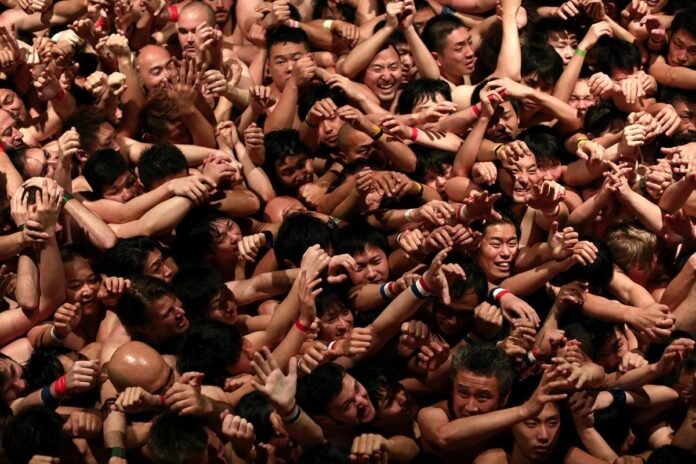The annual Hadaka Matsuri, or “Naked Men” festival, is a long-standing tradition in Japan that has been celebrated for centuries. However, in recent years, this iconic event has been facing challenges due to Japan’s ageing population.
Originating from the Edo period, the Hadaka Matsuri is held at various shrines across Japan, with the most famous being the Saidaiji Temple in Okayama Prefecture. The festival typically takes place in February and involves thousands of men clad only in loincloths competing to grab lucky charms thrown into the crowd by priests.
Despite its cultural significance and popularity among locals and tourists alike, the Hadaka Matsuri has been experiencing a decline in participation in recent years. One of the primary reasons for this decline is Japan’s rapidly ageing population, with many younger individuals choosing not to participate in the physically demanding festival.
Moreover, concerns over safety and hygiene have also contributed to the dwindling attendance at the Hadaka Matsuri. Injuries and accidents during the festival, such as falls and overcrowding, have raised concerns among both participants and organizers. Additionally, the spread of infectious diseases, particularly in large crowds, has become a growing concern in recent years.
Naked Men Festival For a Good Cause
Furthermore, changing social norms and attitudes towards public nudity have also impacted the popularity of the Hadaka Matsuri. In a society where modesty and discretion are valued, the idea of publicly exposing oneself in a crowded setting may be viewed as taboo or inappropriate by some individuals, particularly younger generations.
As a result of these challenges, organizers of the Hadaka Matsuri are facing pressure to adapt and modernize the event to attract younger participants and ensure its continued relevance in contemporary Japanese society. Efforts to promote the festival through social media, as well as initiatives to enhance safety and hygiene measures, have been implemented in recent years in an attempt to revitalize interest in the tradition.
Despite these challenges, the Hadaka Matsuri remains an integral part of Japan’s cultural heritage and continues to attract visitors from around the world. Its unique blend of tradition, spirituality, and spectacle serves as a testament to Japan’s rich cultural legacy and the enduring appeal of its ancient traditions.
As Japan grapples with the challenges of an ageing population and changing social dynamics, the future of the Hadaka Matsuri hangs in the balance. However, with ongoing efforts to adapt and modernize the festival, there remains hope that this iconic tradition will continue to thrive for generations to come.
In response to the declining participation, local communities and festival organizers have been brainstorming strategies to rejuvenate the Hadaka Matsuri and ensure its longevity. One approach involves modernizing certain aspects of the festival while preserving its cultural essence. For instance, incorporating technology and interactive elements into the event, such as live streaming or virtual reality experiences, could attract a younger audience more attuned to digital platforms.
Additionally, efforts are underway to promote the Hadaka Matsuri as a cultural tourism attraction, leveraging its unique appeal to both domestic and international visitors. By highlighting the historical significance and cultural symbolism of the festival, organizers hope to draw interest from tourists seeking authentic cultural experiences in Japan.
Moreover, collaborations with local businesses and tourism agencies have been explored to enhance the overall festival experience and promote economic growth in the surrounding areas. This could involve offering package deals that combine festival participation with accommodations, dining, and sightseeing opportunities, thereby enticing visitors to extend their stay and explore the region further.
Furthermore, educational initiatives aimed at raising awareness about the cultural significance of the Hadaka Matsuri and its role in Japanese society could help instill a sense of pride and ownership among younger generations. By fostering a deeper appreciation for their cultural heritage, organizers hope to inspire greater participation and engagement in traditional events like the Hadaka Matsuri.
Ultimately, the future of the Hadaka Matsuri hinges on the ability of organizers to adapt to changing demographics and societal norms while staying true to its cultural roots. With innovation, collaboration, and community support, there is optimism that this iconic festival will continue to thrive and evolve, serving as a timeless testament to Japan’s rich cultural heritage.

